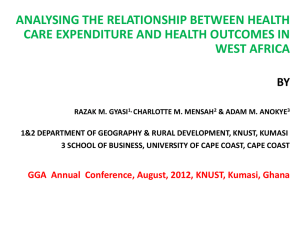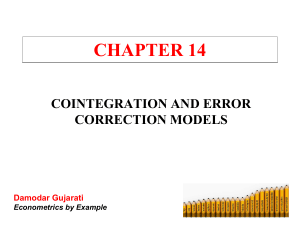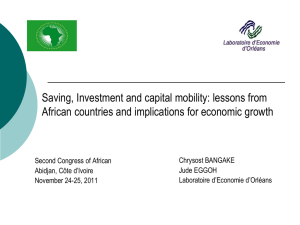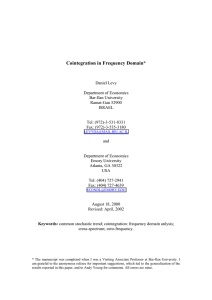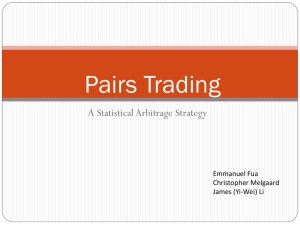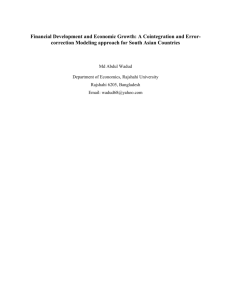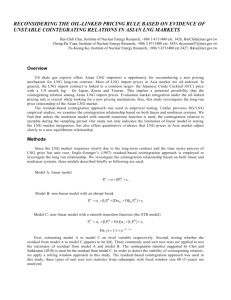Market delineation of fish species in Spain Portsmouth
advertisement
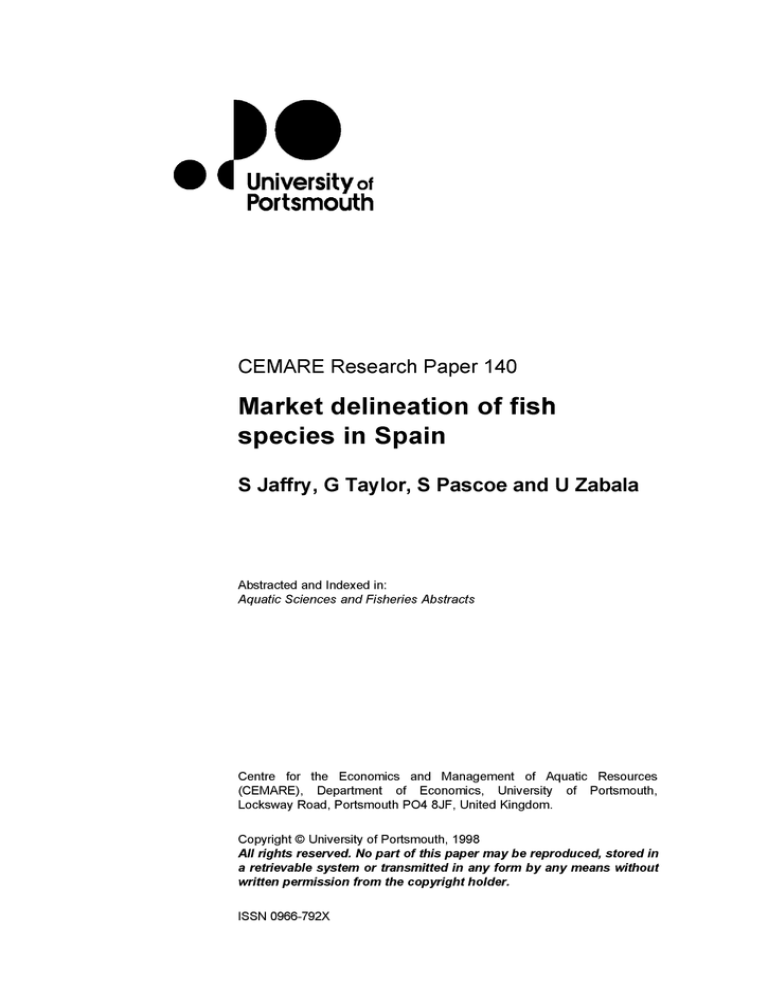
w ( University of Portsmouth CEMARE Research Paper 140 Market delineation of fish species in Spain S Jaffry, G Taylor, S Pascoe and U Zabala Abstracted and Indexed in: Aquatic Sciences and Fisheries Abstracts Centre for the Economics and Management of Aquatic Resources (CEMARE), Department of Economics, University of Portsmouth, Locksway Road, Portsmouth P04 8JF, United Kingdom. Copyright© University of Portsmouth, 1998 All rights reserved. No part of this paper m ay be reproduced, stored in a retrievable system or transmitted in any form by any means without written permission from the copyright holder. ISSN 0966-792X Market delineation of fish species in spain1 Shabbar Jaffry Department of Economics, University of Portsmouth, UK George Taylor, Sean Pascoe and Unax Zabala CEMARE, University of Portsmouth, UK Abstract Spain is the one of the most important markets for fish and shellfish within Europe and the world. Despite this, few attempts have been made to estimate demand relationships. This is largely due to the large number of species on the market. Before such studies can be conducted, inter­ relationships between species need to be defined so that appropriate groupings can be established. In this report, the main fish species in the Spanish market are subjected to econometric testing in order to determine whether a sole market exists containing all the species, and/or to identify any sub-markets. The market delineation analysis is undertaken using a both bivariate and multivariate cointegration methodology. Introduction Spain has the largest fishing fleet within Europe and is estimated to have the ninth largest market in the world (¡VIcFeeters 1991, Bjorndal, Gordon and Salvanes 1992). In addition, Spain is one of the largest per capita consumers o ffis h products (FAO 1995). Spain’s importance, therefore, in terms of both the supply and demand for fish both within and outside the European Union is well recognised. Despite the importance of the Spanish fish market, relatively few studies of demand for fish in Spain have been conducted. These have largely focused on fish as an aggregate group that is in competition with other food types. In some cases, the fish were compared with a range of consumer goods (Abadia 1985, Deaton, Ruiz-Castillo and Thomas 1989). In other cases, fish was considered relative to other food goods lyiolina 1994, Chung 1994, Gracia and Albisu 1995, Lombán and Millari 1996, 1997). More recently, attempts have been made to model demand at the species level (J/lillán 1998, Millari and Aldaz 1998). These latter attempts have been fairly limited. One of the problems raised was the large number of species that could potentially interact. Attempts at determining the interactions using Allais’ (1943) intensity of interaction coefficients in both studies were overly complex and inconclusive. An alternative to the Allais (1943) approach is the use of cointegration techniques to determine market delineation. Similar studies have been undertaken in other countries (see for example Gordon and Hannesson 1996 and Asche et al 1997). As yet market delineation studies have focused either on the EU as a whole or specifically on Salmon and cod markets (Gordon et al 1993, Hannesson 1994, Gordon and Hannesson 1995, Steen, 1995, Asche, Salvanes and Steen 1997, Asche and Steen 1998). In this paper, the key species groups on the Spanish market are determined using this approach. Both the bivariate and multivariate cointegration methodology for delineating markets is employed. If the species form part of the same sub-market, then prices will be found to move together in the long run. One would therefore expect these variable to cointegrate. 1 This study forms part of the EU funded project “The implications for fisheries management systems of interactions between farmed and wild caught species” (FAIR-CT96-1814). 1 Market Delineation Stigler (1969) defines a market as “ the area within which the price of a commodity tends to uniformity, allowance being made for transportation costs” and it is upon this arbitrage-based definition that market delineation studies are based. There is a growing literature on market delineation using time series techniques in testing for price interdependencies (Horowitz 1980, Stigler 1985, Benson and Faminow 1990, Schrank and Roy 1991). Since most price series generally tend to be non-stationary, cointegration analysis has become the most common methodology used in recent years to delineate markets (^rdeni 1989, Goodwin and Schroeder 1991, Gordon, Salvanes and Atkins 1993, Beck 1994, Sauer 1994, Bose and Mcllgorm 1996, Gordon and Hannesson 1996, Asche, Salvanes and Steen 1997). The concept of cointegration “mimics” the existence of a long run equilibrium to which an economic system converges overtime. The implication of identifying cointegration between variables is that a stable long-run relationship exists between the variables in question. From this, it can be assumed that a price parity equilibrium condition exists resulting from the variables forming parts of the same market. Cointegration vectors represent constraints that an economic system imposes on the movement of individual variables in the system in the long run. A difficulty with using cointegration to delineate markets is that variables could be shown to cointegrate even though one or more of the variables do not significantly contribute to the long run relationship (Hamilton 1994). For example, “weak” cointegration may exist between variables that normally have independent processes, but are subject to similar demand shocks (for example). In contrast, market delineation analysis assumes that cointegration between variables reflects the existence of economic activities such as arbitrage and substitution. To correct for this, so-called exclusion tests are undertaken, imposing null restrictions on the long run parameters. Another approach to identifying or indeed facilitating the removal of insignificant variables from a market is to examine the pair-wise cointegration. If a set of goods are in the same market, all prices must be pair-wise cointegrated. The original market delineation studies were heavily based on the US anti-trust law context and investigated the correlation’s of prices between markets (Horowitz 1981, Stigler and Sherwin 1985). Such correlation approaches, however, had several shortcomings. Firstly, common movements due to common costs or demand shocks could lead to high correlation coefficients and thereby support a one-market hypothesis erroneously. Secondly, high correlation coefficients could be obtained from coincidences in price movements of goods that are clearly not in the same market (Stigler and Sherwin 1985). Finally correlation coefficients are not able to account for longrun price responses in that price correlation can suffer significant changes from the short to the long run. In other words correlation coefficients are not able to detect lagged responses to price shocks and could erroneously conclude price series to be uncorrelated, when instead in the long run they could be perfectly correlated and therefore define a single market (Slade 1986). The next generation of models (Uri and Rifkin 1985, Slade 1986, Benson and Faminow 1990) were based upon the works of both Granger (1969) and Sim (1972) concerning causality. Where testing considered whether price determination in one region was exogenous to price information from another region. Uri and Rifkin (1985) and Benson and Faminow (1990) both used autoregressive models to test for Granger causality, whilst Slade (1986) used multivariate autoregressive models (VAR) employing the exogeneity concept in testing for causality. The generations of models outlined above require stationary price series in order to capture the long run properties of a model appropriately. In practice, however, most time series are generally found to be non-stationary in their levels. Non-stationary variables, do however, commonly become stationary after differencing (although not necessarily just by first-differencing). The process of differencing has an associated problem though. It eliminates all information about the long run relationship and thus restricts the ability of a model to account for short-term dynamics (Hendry 1986). Hence, the introduction of the concept of cointegration when testing for market boundaries (Ardeni 1989, Goodwin and Schroeder 1991). 2 The idea of cointegration is that even if two or more variables in themselves are non-stationary in their levels, linear combinations (so-called cointegration vectors) which are stationary may exist (Engle and Granger 1987). When cointegration is verified, the variables exhibit a long run relationship^), which implies the existence of a spatial price parity equilibrium condition. Variables may drift apart due to random shocks, sticky prices, contracts etc. in the short run, but in the long run, economic equilibrium processes force the variables back to their long run equilibrium paths (Engle and Granger 1991). The implication here, therefore, is that cointegration tests are superior when investigating relationships believed to be of a long run nature. The studies of Ardeni (1987) and Goodwin and Schroeder (1991) both utilise the Engle and Granger approach, which is restricted to pair-wise price comparisons bivariate methodology). In practice, however, there are usually more than just two goods/products in question. Such bivariate methods ignore any possible linkages that may operate through another market of goods within the system. In addition there may also be a number of long run equilibrium relationships that will not be fully captured by bivariate methods. Newer studies therefore, have used the multivariate model approach of Johansen (1988, 1991) and Johansen and Juselius (1990). In doing so, these studies account for the problems faced by bivariate methods by providing a matrix with all possible distinct cointegration vectors based on all the variables (Bessler and Covey 1991, Gordon, Salvanes and Atkins 1993, Beck 1994, Sauer 1994, Steen 1995, Bose and Mcllgorm 1996, Schwarz and Mcllgorm 1996, Gordon and Hannesson 1996, Asche, Salvanes and Steen 1997). Variables could still cointegrate even though one or more of the variables do not significantly contribute to the long run relationship. For example, “weak” cointegration may exist where the other variables are seen to be the main contributors to the significant cointegration relationship. Whereby price series that are normally of independent processes are subject to common costs, or demand shocks rather than the economic activities of arbitrage and substitution, i.e. those relevant to market delineation. It has been suggested in Steen (1995), Gordon and Hannesson (1996) and Asche, Slavanes and Steen (1997) that one should impose null restrictions on the long run parameters, so-called exclusion tests, using Johansen and Juselius procedure to ensure the robustness of the cointegration relationships (Hamilton 1994). More recently, however, Asche and Bremnes (1997) suggest an alternative in that if the goods are to be in the same market, then they must all also pair-wise cointegrate. Cointegration methodology Consider two series of economic variables, xt and yt. Each series by itself is non-stationary, and both become stationary after first differencing. A linear combination of the two series, however, may produce a residual series ^ which is stationary. For example, yt - W t = £ t 0) Under these circumstances, the series xt and yt are said to be cointegrated fn g le and Granger 1987). More precisely, they are said to be cointegrated of order (1,1) with the vector [1,-v|/j called the cointegration vector The relationship between Stigler’s (1969) market definition and cointegration is clear. In Stigler’s definition, a stable long run relationship between prices implies those goods to be in the same market. For non stationary data series, cointegration is the only scenario when such series can form such stable long-run relationships. Testing for integration order A pre-requisite for testing for cointegration is to verify the variables’ integration order. The most common method is the test for unit roots developed by Dickey and Fuller (1979; 1981) with a null o f Ft: pa = 1 (i.e. non-stationarity) against the alternative of stationarity such that FJ: p < 1. In such a test, the development in the series yt is assumed to be described as an autoregressive process AR(1). That is, 3 y t = m - i+ £ t (2) where St ~ iid (0,ct). The standard approach to testing such a hypothesis would be to construct a t-test. With nonstationarity, however, the computed statistic does not follow a standard t-distribution but, instead, a Dickey-Fuller distribution. In order to capture autocorrelated omitted variables (which otherwise would, by default, appear in the necessarily autocorrelated error term) common practice has led to the inclusion of the lagged first differenced dependent variables on the right-hand side of (2); k y t = p y t - 1 + Z y à y t - j + et J=l (3) Such practice is commonly referred to as the Augmented Dickey-Fuller (ADF) test. The distribution of the critical values changes with the inclusion of nuisance parameters, such as time trends and constant terms. In order to determine the appropriate lag length, k, it is common practice to start with a sufficiently high k, and then test decreasing k’s until the last lag is found to be significant (Schwert 1989, Campbell and Perron 1991, Harris 1995). Bivariate cointegration tests Some early studies on future/commodity markets have used bivariate Engle and Granger tests for cointegration. Such testing involves estimating the parameters in the possible cointegrating relation (1) by OLS, and then testing the residuals for stationarity. This analysis is undertaken with a null of no cointegration using Dickey and Fuller tests. There are two primary problems with the bivariate procedure of testing for market integration. Firstly, the regression of (1) relies upon an arbitrary normalisation, as economic theory provides no guidance as to which variable to treat as endogenous. The OLS estimates of the cointegration vector are obtained by normalising the parameter belonging to yt to be unity. Clearly, the parameter belong to xt might equally have been normalised. However, this will give different estimates of the cointegration vector, and only when the limiting case of R2being equal to one, will the estimates be identical. The choice of which variable upon which to normalise clearly affects the estimates found and indeed the evidence for cointegration among the series. The second problem associated with the Engle and Granger testing procedure is that no allowance is made for testing parameter restrictions on the cointegration vector. This is of particular importance if one wants to test hypotheses on the parameters in the cointegration vector. One particular hypothesis here, is testing if the law of one price (LOP) holds2. LOP was in fact a motivation for the first papers using cointegration to test for market integration, for example Ardeni (1989). In the Engle and Granger bivariate framework, however, this testing is not possible since normal inference is not valid. This has led to a decline in interest in LOP hypotheses, and instead the focus favours the less-restrictive notion that co-movements of prices, implied by a cointegration relationship, implies market integration. The superiority of the LOP hypothesis in its firmest link between the analysis of co-movements of prices and economic theory, suggests this hypothesis should not be abandoned so quickly. Especially since alternative tests (to Engle and Granger) exist. For example, the Johansen test (Johansen 1988, 1991) enables testing for both cointegration and hypothesis testing on the parameters in the cointegration vector. 2 The LOP hypothesis may be tested by imposing the restriction y = 1. 4 Multivariate cointegration testing Johansen (1998) illustrates a procedure to determine the number of cointegration vectors in a given set of variables. Later expansion (Johansen and Juselius 1990, Johansen 1991) also incorporates analysis for the inclusion of other factors such as deterministic seasonality and time trends. Whilst this methodology is quite complex, its underpinning intuition is somewhat straightforward. In order to find the possible cointegration vectors the data is divided into two groupings, the variables in their levels and their first differences3. Using the technique of canonical correlation, the linear combinations of the data (in their levels) that are highly correlated with the differences are found. If the correlation is sufficiently high, then it follows that these linear combinations are stationary, and thus so are the cointegration vectors. More formally, defining a vector zt of n potentially endogenous variables, it is possible to specify a data generating process, as follows, and model zt as an unrestricted vector autoregression (VAR) with up to k-lags of zt: - A Z t - l + ---+ ^ k Z t~k + ® D t + ß + £t (4) where zt is (nx1) and each of the A is an (nxn) matrix of the parameters, Dt are seasonal dummies orthogonal to the constant term p and St ~ niid(0,Q). Equation (4) can be reformulated in vector error-correction (VECM) form: AZ t = r i A Zt —i+ +IA —i A Zt — k + 1+ YlZt —k + OZJr + L i + £t (5) where, r¡= -(I -A r ...-A¡), (¡ =1, ... ,k-1), and n.= - (I - A - ■■■ - A^. The system now contains information on both the short- and the long-run adjustment to changes in zt, via the estimates of r and I f respectively. The rank of n, r, determines how many linear combinations of zt are stationary . I f = a ß ’ , where a represents the speed of adjustment to dis-equilibrium, while ß is a matrix of long-run coefficients, i.e. contains the cointegration vectors. Johansen and Juselius illustrate that after appropriate factorisation, and by solving an eigenvalue problem, it is possible to test for the number of significant vectors by using two different tests. The first of which, is the Maximum eigenvalue test © , which is a test of the relevance of column r+1 in ß; = - Tin (1-A + 0- The second is the trace test, (r|r) and is a likelihood ratio test for at most, r cointegration vectors; r | r = -T SN i=r+i In (1-1¡). Empirical results The fourteen species4 used in this study (Table 1) account for over 80 per cent of the total production in Spain (Robinson and Pascoe 1998). These species include both the most important aquaculture species as well as the most important wild caught species. In terms of the aquaculture sector (i.e. mussels, salmon and seabass), mussels are the most important domestically farmed species. They account for 90 per cent of Spanish aquaculture production. Salmon, although it has some degree of domestic availability, is mainly from farmed production and imports from more successful aquacultural production countries such as Chile, Denmark and in particular Norway. In terms of wild caught species, hake is the most popular white fish species and accounts for up to 70 per cent of total fish consumption (Emmett 1994). Robinson and Pascoe (1998) provide both an overall description of the Spanish market for further information. Price information in Spain is difficult to obtain, with only annual data covering the period 1977 to 1995 being available. This was insufficient to conduct a multivariate cointegration study. Further, as the growth in aquaculture species in recent years may have resulted in a change in market 3 Differences are to be assumed, under assumption of 1(1) to be stationary. 4 Data for Halibut were unavailable- hence the set of species was reduced to thirteen species. 5 structure, a longer annual time series may have resulted in the analysis reflecting historic patterns rather than current patterns of price movements. Quarterly data on the quantity and value of imports into Spain were available from EUROSTAT. From these, an estimate of the average import price could be derived. An assumption was made that the import prices should reflect the prices paid on the domestic market. As much of the fish are imported fresh (Robinson and Pascoe 1998), imports should be highly substitutable with domestically caught produce. Hence, import prices were used in the analysis as proxies for domestic prices. Prices were converted from ECU to pesetas using and real prices were derived using the Spanish consumer price index. Price fluctuations of the groupings based on a priori expectations are shown in Figure 1. From this there is an apparent similarity in prices in each grouping over the sample period. It is also apparent that most species follow either a slight upward or constant trend except for salmon, which appears to follow a slight downward trend. Prawns and mussels do not appear to follow the same pattern, suggesting that either species may not contribute significantly to the long run relationship. Table 1: The main species in the Spanish Market Species Main source Salmon Farmed Seabass Farmed Mussels Farmed Cuttlefish Wild Octopus Wild Squid Wild Prawns Wild Tuna Wild Hake Wild Whiting Wild Monkfish Wild Cod Wild Sardines (Pilchard) Wild 6 Time period 1984-1996 1988-1996 1988-1996 1984-1996 1984-1996 1988-1996 1984-1996 1984-1996 1984-1996 1984-1996 1984-1996 1984-1996 1986-1996 Figure 1: Logged prices of a priori species groupings prawn "octopus cuttle salmon squid 7.5 mussel 1990 7.5 1995 1990 1995 9 Lcod 8 L salmon 8 Lhake Lhake Lmonk 7 Lwhiting 7 1985 1990 1995 Ltuna 1985 1990 1995 Dickey-Fuller tests were undertaken to investigate the price series stochastic properties, followed by pair-wise (bivariate) cointegration tests and finally by multivariate analysis. The analyses were undertaken using both nominal and real prices. The results for the nominal prices are presented separately in the Appendix. Augmented Dickey-Fuller test results Two tests for units roots were undertaken. Firstly, an augmented Dickey-Fuller test (ADF) including only a constant term, and secondly including both a constant and a trend. The results of these are presented in Table 2. Table 2: Results from Augmented Dickey Fuller Tests. Species ADF-test No. of lags inc. constant Salmon -1.3919 5 Cod -3.0759* 5 Whiting -2.3152 5 -4.4465** Monkfish 5 Hake -2.9071 5 Tuna -3.1786* 5 Mussels -4.3676** 5 Squid -5.2454** 5 Cuttlefish -0.42270 5 Octopus -1.5926 5 Prawns -4.9198** 5 Sardines -2.8637 5 Seabass -3.5772* 5 * significant at the 5% level, ** significant at the 1% level ADF-test inc. constant and trend -2.3797 -2.8949 -2.2726 -3.9535* -4.5414** -3.3469 -4.2999** -5.2730 -1.9829 -3.0330 -5.4758** -2.7200 -4.9415** No. of lags 5 5 5 5 5 5 5 5 5 5 5 5 5 In most circumstances it is not necessary for all the variables in the model to have the same order of integration, though it is important to understand the implications when all the variables are not 7 all 1(1) (Harris 1995)5. All thirteen species were found to be non-stationary in their levels using five lags. Bivariate cointegration test results The analysis starts by undertaking bivariate Johansen for all the species. With 13 species, we therefore have 78 possible cointegrating relationships. Undertaking both the maximum eigenvalue and the trace test produces a total of 156 separate test statistics to evaluated. To facilitate this procedure the results are presented according to different species groupings- a wild fish category, shellfish category and a farmed fish category. The results for wild caught fish species are presented in Table 3, shellfish in Table 4 and farmed fish in Table 5. Bivariate cointegration tests between species in different groups are presented in Tables 6 to 8. Close inspection of the distribution of these cointegration results leads to several conclusions. Firstly, there is little evidence in favour of one integrated fish market containing all 13 species in Spain. Secondly, sub-markets, where some close substitutes are interrelated, would appear to exist. In terms of the wild fish grouping there would appear to be a “white fish” market consisting of Monkfish, Hake and Cod. Whereby all possible relationships are found to cointegrate. With the shellfish grouping, there would appear to be evidence of a sub-market consisting of squid, octopus and cuttlefish and moreover, a sub-market containing prawn and mussel. The farmed fish species of salmon and seabass would also appear to comprise another sub-market. In terms of cross-grouping integration, salmon was found only to integrate with squid, octopus and prawn from the shellfish group; and with only monkfish from the wild species group. There is no reason therefore to believe that salmon competes with the wild fish species. This result complies with the results of similar studies in the EU (Gordon and Hannesson 1996, Asche and Hannesson 1997). The next section illustrates the results of the multivariate analyses and tests whether the groupings “suggested” by the bivariate tests are correct. Table 3: Bivariate Cointegration Results - Wild Fish. Tuna Hake Whiting Cod Sardines Monkfish Tuna Hake 8.2 1 4 / 13.17 Whiting 13.83/ 15.69*/ 17.44 20.67* Cod 17.16*/ 7 .2 8 /1 0 .0 6 6.68 / 8.701 20.94* Sardines 19.49*/ 7.991 / 10.97/ 11.79/ 28.6** / * 12.81 14.55 17.47 Monkfish 18.45*/ 36.64** / 40.05** / 37.23** / 18.18**/ 29.59* 44.91** 42.08** 41.63** 21.06** The first value refers to the maximum eigenvalue test, while the second refers to the trace test. * Significant at 5% level, ** significant at 1% level. 5 This is because cointegration tests with at least one stationary series will be biased towards concluding the presence of cointegration. This become apparent when considering two series, one that is stationary and one that contains a unit root and is therefore non stationary. Using the Johansen procedure the only possible cointegration vector that will exist is the vector that sets the parameter belonging to the non stationary series to zero. Hence the cointegration vector will be [0,-1], where all weight is bestowed to the stationary series. Obviously the vector is a stationary solution, but is meaningless in terms of market integration. After all, there is no relationship between the series, and hence there is no reason to suggest that these products belong to the same market (Asche and Steen 1998). 8 Table 4: Bivariate Cointegration Results - Octopus. Squid Octopus Cuttlefish Prawn Mussel Squid Octopus 40.53** / 45.66** Cuttlefish 30.53** / 32.2** 17.12*/20.09* Prawn 29.58** / 31.0**/31.91** 29.41**/ 30.46** 32.39** Mussel 49.56** / 39.5**/41.58** 1 5 .5 7 /1 6 .3 17.43**/ 55.11** 17.97** The first value refers to the maximum eigenvalue test, while the second refers to the trace test. * Significant at 5% level, ** significant at 1% level. Table 5: Bivariate Cointegration Results - Farmed Species. Salmon Salmon Seabass 1 4.16/15.19 Seabass The first value refers to the maximum eigenvalue test, while the second refers to the trace test. * Significant at 5% level, ** significant at 1% level. Table 6: Bivariate Cointegration results - Wild fish and Octopus. Tuna Hake Whiting Cod Squid 22.69** / 36.31**/ 41.64** / 37.75** / 22.92** 38.61** 42.71** 42.04** Octopus 10.02/ 13.15/ 13.74/ 12.91 / 16.33 16.28 16.26 17.47 Cuttlefish 9 .6 6 / 10.44/ 9.838 / 6.768 / 12.33 11.66 14.45 8.889 Prawn 39.79** / 23.61**/ 27.91**/ 39.14**/ 42.31** 27.77** 32.44** 43.2** Mussel 12.88*/ 13.52/ 14.33/ 23.45** / 12.96* 16.18 15.67 28.83** The first value refers to the maximum eigenvalue test, while the second * Significant at 5% level, ** significant at 1% level. Monkfish 13.01*/ 13.1* 29.83 / 30.41 35.3** / 37.61** 32.51**/ 33.06** 17 .2 */ 26.11** Sardines 38.66** / 44.45** 13.97/ 17.67 8.297 / 11.16 49.6** / 57.03** 10.69/ 17.66 refers to the trace test. Table 7: Bivariate Cointegration Results -■Wild fish and Farmed Species. Hake Whiting Cod 9.091 / 7.41 /7 .7 4 7 7 .8 8 9 / 10.721 9.504 Seabass 17.31*/ 6.382 / 10.45/ 18.55 7.399 13.21 The first value refers to the maximum eigenvalue test, while the second * Significant at 5% level, ** significant at 1% level. Salmon Tuna 13.58/ 16.06 10.31 /1 3 .5 Sardines 10.01 / 11.85 6.565 / 10.15 refers to the Monkfish 41.12**/ 45.93** 20.82** / 24.32** trace test. Table 8 : Bivariate Cointegration Results - Octopus and Farmed Species. Squid Octopus Cuttlefish Prawn Mussel Salmon 38.42** / 45.33** 12 .9 4 / 15.6 3 .124/ 31.09**/33.64** 17.45*/ 6.035 25.22** Seabass 45.17**/47.9** 41.69** / 42.3** 6.277 / 45.61**/46.74** 21.68**/ 7.711 24.5* The first value refers to the maximum eigenvalue test, while the second refers to the trace test. ‘ Significant at 5% level, ** significant at 1 % level. 9 Multivariate Cointegration Test Results The results of the bivariate cointegration tests provide some indications of possible groupings of species that should competing in the same market segment. As expected with the large number of tests undertaken there is some conflicting evidence. Nesting all the tests into the same system would be the most obvious solution (^sche and Steen 1998). Such a process, however, leads to what Hendry (1996) describes as the “curse of dimentionality”, in that the more variables included in the system, the more quickly the available degrees of freedom will dissipate. The results of the bivariate tests are therefore used to aid the specification of the multivariate systems. The bivariate cointegration results for wild fish species, displayed in Table 3, suggest evidence of a “white fish” market. The first multivariate system specified is therefore a white fish segment with a z it vector specified as: Zu = (6) ^ g p cod, \ o g p hake, \ o g p monkfish Multivariate systems were also specified for squid, octopus and cuttlefish; salmon, prawns and mussels; and salmon, tuna, whiting and hake. The z it vectors can be specified as: Z 2i = [log p squid , log p octopus, log p cuttle *] (7) t — [log P salmon , log P tuna >1® Q Pw hiting lo§ Phake ] (8) Zaí — [logP salmon , log Pprawn (9) Z ? > ■> ■ Pmussel \ (10) the corresponding cointegration results of which, are displayed in Tables 9, 10, 11 and 12 respectively. CM CRITICAL VALUE (5%) 53.1 34.9 20.0 9.2 o Table 11: Johansen (Multivariate) Test - Salmon, Tuna, Whiting and Hake. H0: RANK = P MAX TEST CRITICAL VALUE TRACE TEST (5%) 36.19** 28.1 68.15** p <= 1 20.47 22.0 31.96 10.71 15.7 11.49 p<= 3 0.7829 9.2 0.7829 significant at 1% level. Q. CRITICAL VALUE (5%) 34.9 20.0 9.2 II V Table 10: Johansen (Multivariate) Test - Squid, Octopus and Cuttlefish. H0: RANK = P MAX TEST CRITICAL VALUE TRACE TEST (5%) 32.87** 22.0 46.13** p <= 1 10.32 15.7 13.25 2.934 9.2 2.934 ** significant at 1% level. II II CRITICAL VALUE (5%) 34.9 20.0 9.2 Q_ Table 9: Johansen (Multivariate) Test - Cod, Hake and Monkfish. H0: RANK = P MAX TEST CRITICAL VALUE TRACE TEST (5%) 52.28** 22.0 66.2** p <= 1 12.35 15.7 13.92 1.567 9.2 1.567 ** significant at 1% level, * significant at 5% level. Q_ II II o Q. II V CM Q_ II II o Q_ II V CM 10 Q_ II II o Q. II V CM Table 12: Johansen (Multivariate) Test - Salmon, Prawn and Mussels. H0: RANK = P MAX TEST CRITICAL VALUE TRACE TEST (5%) 47.36** 22.0 67.03** p <= 1 15.12 15.7 19.67 4.55 9.2 4.55 ** significant at 1% level. CRITICAL VALUE (5%) 34.9 20.0 9.2 As can be seen from the relevant tables, only one cointegration vector was identified in each scenario multivariate analysis. In other words, four sub-markets have been identified. Further analysis with the inclusion of other species, believed (with a priori intuition) to be linked provided no evidence in support any expansion of these groupings. As previously stated, variables could cointegrate even if one or more of the variables did not significantly contribute to the long-run relationship. Exclusion tests are therefore imposed upon the long-run parameters in the four submarkets. The results of the normalised cointegration vectors from all four sub-markets are presented in Table 13. Using a t-test analysis the constant from group 1 and cuttlefish from group 2 can be seen to be possibly insignificant (only significant at 10% perhaps less significant). Exclusion tests were undertaken for both species, imposing the null that long-run parameters are equal to zero. Such a test produces 2 statistics which for the group 1 constant, 2(1) = 1.2861 [0.2568] proving to be significant. For cuttlefish, 2(1) = 1.7182 [0.1899] which again is proved to be significant. This suggests that these variables do not contribute significantly to the long-run relationship of their respective groups and indicating that cuttlefish is possibly a weak substitute its market. Exclusion tests on the variables in the other two groups, i.e. groups 3 and 4, indicate that not all the variable contribute significantly to their respective long-run relationships. In group 3, when normalised with respect to salmon, all the variables are found to contribute significant to the longrun relationship. Salmon, however, with normalisation with respect to tuna, is found not to contribute significantly to the long-run relationship. The null that Salmons’ long-run parameters are equal to zero is accepted with a 2 statistic, 2(1) = 0.64734 [0.42111]. Indicating that this species is possibly a weak substitute in this market. In group 4, all variables are found to be significant indicating the existence of a sub-market of containing salmon, prawns and mussels. Table 13: Restricted: Normalised Cointegration Vectors (for all groups). Group 1 Hake Cod Monk Constant 1.0000 -2.1062*** 2.0410*** -7.8529* Group 2 Squid Octopus Cuttlefish Constant 1.0000 0.29273*** -0.11652* -9.1814*** Group 3 Salmon Tuna Hake Whiting 1.0000 5.7908*** -16.832*** -2.9799*** Group 4 Salmon Prawn Mussel Constant 1.0000 -2.7702*** -0.70208*** 19.060*** * significant at 10%; ** at 5% and *** at 1%. Constant 115.51*** Conclusion and Discussions Using bivariate cointegration tests, little evidence of an integrated market for all 13 species is found. The results do, however, suggest possible sub-markets. The multivariate analysis of these suggested markets provide evidence of cointegration vectors and indeed market segments. The analysis suggested that the 13 species could form four separate groups. The first group consists of hake, cod and monkfish. These are the main white fish species consumed in the home 11 (Robinson and Pascoe 1998), although monkfish is generally considered a higher valued species than hake and cod. Hake is the main species consumed in the home. A second group consists of the main cephalopod species (cuttlefish, octopus and squid). It is likely that these species would be readily substitutable so would be expected to follow similar price trends. The third group consists of tuna, hake and whiting. Tuna and whiting are also main fish species consumed in the home. They do not interact directly with cod and monkfish, but are cointegrated with hake. Salmon was initially found to be cointegrated with this group but was excluded as a result of the exclusion tests. The results suggest that hake is to some extent a market leader, influencing the prices of cod, monkfish, tuna and whiting. However, tuna and whiting are substantially different species to cod and monkfish. The first two species are relatively oily, flakey fleshed species while the latter two are firmer and sweeter fleshed fish. Salmon was not cointegrated with the other fish species, although on a bivariate basis was cointegrated with monkfish. As both were historically high valued (in terms of price) species, it is possible that the prices were related to some extent. However, on a multivariate basis, monkfish formed part of the first group, suggesting the price movements have been more in line with the wild caught species than the high valued farmed species. This suggests that salmon is part of a separate market than the other fish species. Seabass was also not found to be cointegrated with other species on a multivariate basis. On a bivariate basis, it was found to cointegrate with monkfish, squid, prawn and mussel. Again, both seabass and monkfish are both high valued species. A grouping consisting of monkfish, seabass and salmon were examined but no significant relationship was found. The cointegration with squid, prawns and mussels may be spurious as there is no a priori reasoning to suggest these species could form part of the same market. The final group consisted of salmon, prawns and mussels. Prawns and mussels could be expected to be substitutes on the market. However, as noted above there is no a priori rationale to suggest that salmon would form part of this market so the result may be spurious. Analysis with nominal prices in place of real prices (given in the Appendix) provides similar evidence of the suggested markets6. The exclusion test results, however, suggest that different species within these groups should be excluded. In terms of nominal prices both hake and mussels do not contribute significantly to the long-run relationship of their respective groups. Exclusion tests were undertaken for both species, accepting the null on both occasions, indicating both species to be weak substitutes within their market grouping. Exclusion tests on the variables in the other two groups, i.e. groups 2 and 3, indicate that all the variables do contribute significantly to the long-run relationship; providing evidence of two sub-markets in which the relevant species integrate. A key finding of the study is that the two farmed fish species examined (salmon and seabass) were not cointegrated with the other fish species. Salmon has experienced increasing growth in production over the period examined and correspondingly falling real prices. Seabass is a relatively new species on the Spanish market and production levels are still relatively low but increasing. For the wild fish species, stocks have either remained stable or decreased over the period examined. As a result, supplies have also remained stable or fallen. The different underlying supply conditions may have influenced the price formation resulting in a divergence between prices. In addition, salmon is largely imported while seabass imports make up about half the total consumption. Hence the prices will be largely driven by demand and supply of these species on the world market, of which Spain is not a major component. In contrast, Spain is the main European market for many of the wild caught species examined (Robinson and Pascoe 1998). As a result, the prices for these species will be dependent upon supply and demand conditions on the Spanish market. 6 Group 4 no longer contains Salmon. 7 The exchange rate is included in the analysis with real prices but excluded with nominal prices. 12 The results of this study indicate that there is integration between certain species within the Spanish fish market. One may need to undertake demand analysis, however, to determine how strong these relationships actually are. Acknowledgements Data used in the study were provided by Frank Asche from the Norwegian School of Economics and Business Administration, Bergen. The study was conducted as part of the EU funded project “The implications for fisheries management systems of interactions between farmed and wild caught species” (FAIR-CT96-1814). The report, however, does not necessarily reflect the views of the Commission of the European Communities and in no case anticipates the Commission’s position in this domain. Appendix: Cointegration results using nominal prices The analysis was also undertaken using nominal prices. While the cointegration analysis should not be affected by similar movements in prices due to general inflationary pressure, it was decided to test this by conducting the analysis using both sets of prices. The results form the analyses using nominal rather than real prices are presented in Tables A1 to A5. These results can be compared with the results presented previous. From these results, analysis with nominal prices in place of real prices provides similar evidence of the suggested markets. The exclusion test results, however, suggest that different species within these groups should be excluded. In terms of nominal prices both hake and mussels do not contribute significantly to the long-run relationship of their respective groups. Exclusion tests were undertaken for both species, accepting the null on both occasions, indicating both species to be weak substitutes within their market grouping. Exclusion tests on the variables in the other two groups, i.e. groups 2 and 3, indicate that all the variables do contribute significantly to the long-run relationship; providing evidence of two sub-markets in which the relevant species integrate. Q_ II II o Q. II V CM Table A1: Johansen (Multivariate) Test - Cod, Hake and Monkfish. H0: RANK = P MAX TEST CRITICAL VALUE TRACE TEST (5%) 30.98** 22.0 49.36** p <= 1 14.74 15.7 18.38 3.639 9.2 3.639 ** significant at 1% level. CRITICAL VALUE (5%) 34.9 20.0 9.2 Q_ II II o Q. II V CM Table A2: Johansen (Multivariate) Test - Squid, Octopus and Cuttlefish. H0: RANK = P MAX TEST CRITICAL VALUE TRACE TEST (5%) 37.55** 22.0 53.66** p <= 1 15.39 15.7 16.1 0.7189 9.2 0.592 ** significant at 1% level. Q_ II II o Q_ II V CM Table A3: Johansen (Multivariate) Test - Salmon, Tuna, Whiting and Hake. H0: RANK = P MAX TEST CRITICAL VALUE TRACE TEST (5%) 56.67** 31.5 89.81** p <= 1 16.25 25.5 33.14 11.54 19.0 16.89 p<= 3 5.351 12.3 5.351 ** significant at 1% level. 13 CRITICAL VALUE (5%) 34.9 20.0 9.2 CRITICAL VALUE (5%) 63.0 42.4 25.3 12.3 o II II Q_ Table A4: Johansen (Multivariate) Test - Prawn and Mussels. H0: RANK =: P CRITICAL VALUE TRACE TEST MAX TEST (5%) 60.42** 15.7 65.3** p <= 1 4.876 9.2 4.876 ** significant at 1% level. Table A5: Restricted: Normalised Cointegration Vectors (for all groups). Group 1 Cod Hake Monk Constant 1.0000 0.18541 -1.7683*** 2.3969** Group 2 Squid Octopus Cuttlefish Constant 1.0000 -2.4500*** -1.2693*** 12.116*** Group 3 Salmon Tuna Hake Whiting 1.0000 -0.82420*** 0.87543*** -0.18096*** Group 4 Prawn Mussel Constant 1.0000 0.046845 -4.7815*** * significant at 10%; ** at 5% and *** at 1%. 14 CRITICAL VALUE (5%) 20.0 9.2 Trend 0.025926*** References Abadía, A. 1985. Income distributions and composition of consumer demand in the Spanish economy. European Economic Review, 29:1-13. Allais, M. 1943. Traité D ’Economic Pure I, Imprimerie Nationale, Paris. Ardeni, P. G. 1989. Does the law of One price really hold for commodity prices?, American Journal o f Agricultural Economics, 71: 661-69. Asche, F. and Steen F. 1998. The EU fish market, SNF report XX/98, FAIR project CT96-1814 DEMINT. Asche, F., Salvanes, K. G. and Steen F. 1997. Market delineation and demand structure, American Journal o f Agricultural Economics, 79(1):139-150. Beck, S. E. 1994. Cointegration and market efficiency in commodities futures markets, Applied Economics, 26: 249-257. Benson, B. L. and Faminow, M. D. 1990. Geographic price interdependencies and the extent of economic markets, Economic Geography, 66: 677-688. Bessler, D. A. and Covey, T. 1991. Cointegration: Some results on cattle prices. Journal o f Future Markets, 11: 461-474. Bjorndal, T., Gordon, D. V. and Salvanes, K. G. 1992. The market for salmon in Spain and Italy. Marine Policy, September: 338-344. Bose, S. and Mcllgorm, A, 1996. Substitutability among species in the Japanese tuna market: A cointegration Analysis. Marine Resource Economics, 11(3): 143-156. Campbell, J. Y. and Perron, P. 1991. Pitfalls and opportunities: What macroeconomists should know about unit roots, in Blanchard, O. J. and Fischer, S (eds.) NBER Economics Annual 1991 MIT Press. Chung, C. 1994. A cross section demand analysis of Spanish provincial food consumption. American Journal o f Agricultural Economics, 76: 513-521. Deaton, A. S., Ruiz-Castillo, J, and Thomas, D. 1989. The influence of household composition on household expenditure patterns: theory and Spanish evidence. Journal o f Political Economy, 97(1): 179-200. Dickey, D. A. and Fuller, W. A. 1979. Distribution of the estimators for autoregressive time series with a unit root. Journal o f American Statistical Association, 74: 427-431. Dickey, D. A. and Fuller, W. A. 1981. Likelihood ratio statistics for autoregressive time series with a unit root. Econometrica, 49: 1057-72. Emmett, I. 1994. Tradition rules in Spain. Seafood International, 9(8): 29-31. Engle, R.F. and Granger, C. W. J. 1987. Cointegration and error correction: representation, estimation and testing. Econometrica, 55(2): 251-276. Engle, R.F. and Granger, C. W. J. 1991. Long-run economic relationships, readings in Cointegration. Advanced texts in Econometrics. Oxford University Press. Goodwin, B. K. and Schroeder, T. C. 1991. Cointegration and spatial price linkages in regional cattle markets. American Journal o f Agricultural Economics, 73(2): 452-464. 15 Gordon, D. V. and Hannesson, R. 1996. On the price of fresh and frozen cod. Marine Resource Economics, 11: 223-238. Gordon, D. V., Hobbs, J. E. and Kerr, W. A. 1993. A test for price integration in the EC lamb market. Journal o f Agricultural Economics, 44(1): 127-134. Gordon, D. V., Salvanes, K. G. and Atkins, F. 1993. A Fish is a Fish is a Fish: Testing for market linkage on the Paris fish market. Marine Resource Economics, 8(4): 331-343. Gracia, D. V. and Albisu, L. M. 1995. La demande de productos cárnicos y pescados en España: aplicación de un sistema de demanda casi ideal (AIDS). Investigación Agraria Economía, 10(2): 233-52. Granger, C. W. J. 1969. Investigating causal relations by Econometric models and cross-spectral methods. Econometrica, 37: 424-428. Granger, C. W. J. 1986. Developments in the study of cointegrated economic variables. Oxford Bulletin o f Economic Statistics, 48(3): 213-228. Hamilton, J. D. 1994. Time Series Analysis. Princeton, New Jersey, Princeton University Press. Harris, R. I. D. 1995 Using cointegration analysis in econometric modelling. Hemel Hemsteaf: Prentice Haii / Harvetser Wheatsheaf. Hendry, D. F. 1986. Econometric modelling with cointegrated variables: An overview. Bulletin o f Economic Statistics, 48(3): 201-212. Oxford Horowitz, I. 1981. Market definition in anti-trust analysis: A regression based approach. Southern Economic Journal, 44: 215-238. Jaffry, S., Pascoe, S. and Robinson, C. 1997. Long-run price flexibilities for high valued species in the UK: A cointegration systems approach. CEMARE Research Paper No. 111. Johansen, S. 1988. Statistical analysis of cointegration vectors. Journal o f Economic Dynamics and Control, 12: 231-54. Johansen, S. 1991. Estimation and hypothesis testing of cointegration vectors in Gaussian autoregressive models. Econometrica, 59(6): 1551-80. Johansen, S. and Juselius, K. 1990. Maximum likelihood estimation and inference on cointegration - with applications to the demand for money. Oxford Bulletin o f Economics and Statistics, 52: 169-210. Lombán, J. and Millari, J. A. 1996. A dynamic analysis of inverse demand for meet in Spain. Paper presented at the Vlllth European Congress of Agricultural Economists, Edinburgh. Lombán, J. and Millari, J. A. 1997. Regional preferences in demand for meet in Spain. Paper presented at the XXIIIth International Conference of Agricultural Economists, Sacramento. McFeeter, B. D. 1991. The Spanish market for squid. Marine Fisheries Review, 52(2): 38-43. Millari, J. A. 1998. An econometric model of Spanish fisheries. Paper presented at the IXth biennial conference of the International Institute of Fisheries Economics and Trade, 8-11 July, Tromso, Norway. 16 Millán, J. A. and Aldaz, N. 1998. An analysis of demand for fresh and frozen fish species in Spain. Paper presented at the IXth biennial conference of the International Institute of Fisheries Economics and Trade, 8-11 July, Tromso, Norway. Molina, J. A. 1994. Food demand in Spain: An Application of the Almost Ideal System. Journal o f Agricultural Economics, 45(2):252-258. Sauer, D. G. 1994. Measuring economic markets for imported crude oil. Energy Journal, 15(2): 107-123. Schrank, W. E. and Roy, N. 1991. Market delineation of US groundfish demand. The Antitrust Bulletin, 36(1): 91-154. Sims, C. 1972. Money, income and causality. American Economic Review, 62: 540-52. Slade, M. E. 1986. Exogeneity tests of market boundaries applied to petroleum products. The Journal o f Industrial Economics, 34(3): 291-303. Stigler, G. J. 1969. The Theory o f Price. London, Macmillan Company. Stigler, G. J. and Sherwin, R. A. 1985. The extent of the market. Journal o f Law and Economics, 28: 555-585. Uri, N. D. and Rifkin, E. J. 1985 Geographic markets, causality and railroad deregulation. The Review o f Economics and Statistics, 67(3): 422-428. Zabala, U. 1998. Price linkages in the Spanish fish market: A multivariate cointegration approach. MSc Fisheries Economics Dissertation, University of Portsmouth. 17
